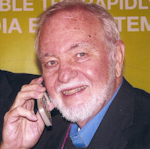(Image courtesy of Thinkstock).
Ethernet is that “invisible” network we all use to communicate. It is that wired infrastructure we all take for granted. It has been around for decades and is still evolving. From its humble beginnings in 1973 as a 2.92 Mb/s coax bus to today’s 10 Gb/s twisted pair and 100 Gb/s fiber versions, Ethernet has more room to grow and change. Here are three new versions of this ubiquitous network technology you should know about.
NBASE-T
The first standardized version of Ethernet was IEEE 802.3 and it had a speed of 10 Mb/s. There were two coax versions and a later unshielded twisted pair (UTP) version 10BASE-T. Enhanced versions came along with decade increases in speed from 10 Mb/s to 100 Mb/s next to 1 Gb/s and then 10 Gb/s. UTP versions are the most popular, but fiber versions are available. And today we have several 100 Gb/s fiber versions on the shelf. These decade speed increases were difficult to achieve. Often they were overkill and too expensive for some applications. The first sign of this was the creation of a 40 Gb/s version that was less expensive with more range than the 100 Gb/s versions. That got the networking community thinking that decade advances were not always necessary for a wide range of applications. Lower cost was more often the rationale for interim speed versions. As a result, we will soon be seeing some more intermediate speed variants at 2.5/5, 25/50, and 400 Gb/s.
One of these is the so-called NBASE-T that uses speeds of 2.5 or 5 Gb/s. One of the main reasons for developing this version was the need to upgrade the widespread 1 Gb/s LANs so they could accommodate the extra speeds available in the new 802.11ac Wi-Fi access points (APs). This version of Wi-Fi can achieve speeds up to 6 Gb/s under some conditions only to be limited by the APs Ethernet connection.
One obvious solution is to upgrade to the 10 Gb/s version. However, most of the installed Ethernet cable networks are Cat 5e or Cat 6, which do not support 10Gb/s to 100 m—not to mention the much higher equipment costs. Ten Gigabit Ethernet needs new Cat 6a cabling and who wants to have to rewire the office or campus. Several manufacturers came along and defined a new version that uses the installed cabling to achieve 2.5 or 5 Gb/s.
NBASE-T uses a new Ethernet PHY based upon heavy DSP. This new PHY uses auto-negotiation to select just the right speed and is even backward-compatible with 100 Mb/s and 1 Gb/s equipment. It is ideal for the new 11ac Wi-Fi APs and will also benefit other applications in industry, video surveillance, and storage.
This new version of Ethernet is supported by the 40-plus member companies of the NBASE-T Alliance. The IEEE now has a working group in progress to make this version a formal standard 802.3bz. Ratification is expected in September 2016. In the meantime, several companies like Cisco already have NICs and switches available for you early adopters.
802.3by
Faster versions of Ethernet have made the standards far more complex and expensive. The 100 Gb/s versions are available now, but expensive, and are excessive for some applications. That is why intermediate speed versions are getting attention. 802.3by is the 25 Gb/s version under development. It is designed for data center interconnects between servers and switches. The goal is to create single-lane (wire, fiber, etc.) alternatives that are less expensive. Several physical layer versions are envisioned including a PCB backplane, copper twin axial cable, and one for multimode fiber (MMF). While there is usually no need for 100 meter versions in a data center, the standard includes this alternative. A version with four twisted pairs is also an option. The final standard is estimated to be done by fall of 2016.
400 Gb/s
Yes, 400 Gb/s. It had to happen. The leap of x10 from 100 Gb/s to One Terabit (1 Tb/s) is just too great. And with multiple parallel lane versions of 100 Gb/s available as a base, it is doable. The 400 Gb/s standard effort is designated 802.3bs. The development program centers around different variants using multiple parallel paths either separate fibers or separate wavelengths (λ) on one single mode fiber (SMF). Four 100 Gb/s lanes will do the job. Other variations include eight 50 Gb/s lanes or 16 25 Gb/s lanes using NRZ. Other options use PAM4 modulation that encodes two bits per symbol and cuts the number of lanes in half at those speeds.
There are many variations under consideration and these will address the different range version from PCB backplanes to 100 and 500 meters as well as 2, 10, and 40 km. Work on 802.3bs will probably run into 2017.
As for what is next, look for the inevitable 1 Tb/s standard in the years to come. Technology has to catch up first.


